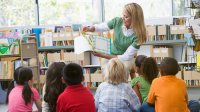Going Beyond a Diverse Classroom Library
By using culturally inclusive texts to spark conversation, teachers can help young learners get the most out of these books.
Your content has been saved!
Go to My Saved Content.You’ve diversified your classroom library—now what?
We have been inundated with information telling us we need books that allow our students to see themselves in the text. We have created Amazon Wish Lists, DonorsChoose projects, and everything in between to make it happen. Now what?
Unfortunately, for a number of teachers, that’s that. All of these books will sit in the pretty bins that have been color-coded and labeled just for them. A student may glance at them every now and again, maybe even thumb through one during independent reading time. As far as these teachers are concerned, they have done their part.
But in reality, the real work has just begun.
Classroom libraries should include culturally inclusive texts. More important, though, teachers should be using these texts to affirm and challenge students in real and intentional ways.
How do we do that?
It starts with read-alouds. Instead of dropping the books in a bin in your classroom library, put them in your daily lineup. We know that students benefit from being read aloud to on a daily basis, so be conscious of the books you’re choosing to read. Think about how texts can be tied into your existing curriculum. Teaching about drawing conclusions? This skill can be applied to many books, and I am sure that one of your diverse texts will fit the bill. Consider using different texts even when introducing math or science concepts. It may take a little more time to prepare the lesson, but it will be worth it to allow students another opportunity to see themselves in literature.
Let’s not stop there. Take things a step further by allowing students to really discuss the texts. Every day, students surprise us with how insightful and perceptive they can be in their thinking. Give your class time to make connections to the characters and the story line. Allow them to talk about parallels they see with their own lives, or even more important, highlight those that they do not see. In his book Visible Learning for Teachers, John Hattie, director of the Melbourne Education Research Institute, writes that student discussion has a considerable effect on student achievement. Let’s push the envelope and allow for authentic discussions that will affirm students and teach them how to affirm others.
Making Space for Courageous Conversations
Don’t be afraid to have a discussion about race in your classroom. Of course, you’ll want to tread lightly with a group of first graders. But if you are in a grade level that can handle it, don’t be reluctant to let it happen. Fourth and fifth grade would be a great time to begin having some of these more mature conversations. Now, more than ever, most of us are aware of the inequities inherent in our society; this includes our kids. Sometimes we can be naive to the fact that our students from different backgrounds are forced to grapple with racial issues every day. The classroom should be a place where students are comfortable and able to discuss such things. Allow your read-aloud to be the springboard that students need to facilitate difficult dialogues.
I understand that for some of us, this may be easier said than done. When we think about potential pushback from parents or administrators, the idea of a courageous conversation can be daunting. But don’t let that stop you. Instead, plan for it. We know that there are likely to be some raised eyebrows. So think about your rationale for the discussion ahead of time. Maybe you are drawing connections to a protest that a student saw in their neighborhood or helping explain why we keep seeing a certain slogan. Back up your decision by citing the relevance to your students. Students learn best when they are engaging with topics that they feel connected to. So be ready to highlight those connections.
Lastly, use your library to bridge the gap between the classroom and the real world. Books already help us to make real-life connections to what we are learning. Think of how much more you will be able to do this when using diverse texts. Choose titles that deal with current events and address topics in the news. Let your literature open the door to the world around you.
The best part about all of this? It can be done virtually. Don’t wait until you are back in the classroom to pull out all of your diverse books. We are charged with the task of creating a community that fosters social and emotional well-being in all of our students; that task has not been put on hold just because we are not physically together. Use the time you have now to get started. Morning meetings are a great place to embed mini lessons that support social and emotional growth. Consider choosing a diverse text each week and building a discussion around it. Every discussion does not have to be long and drawn out. But each one should be intentional and inclusive.
Whether it’s over Zoom, Google Classroom, Canvas, or some other platform, find a way to read to your students. Find a way to foster classroom discussions and build community. Find a way to have those courageous conversations that ultimately help us make sense of the world around us. As teachers, we must do what we can to ensure that our students feel affirmed in who they are, and we must challenge them to learn to do the same for others.
